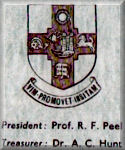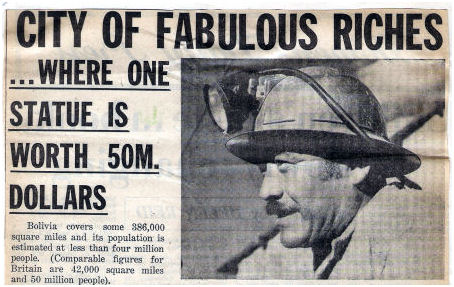University
of Bristol Trans-Continental Expedition 1960 — 61 | ||||||||
| ||||||||
| published 26 June 1961 | ||||||||
Bolivia covers some 386,000 square miles and its population is estimated at less than four million people. (Comparable figures for Britain are 43,000 square miles and 50 million people. Of this population, 72 per cent live between 6 ½ and 15 ½ thousand feet above sa-level, in an area probably about one quarter of the whole country. This is the highland of the Altiplano and south to the mining districts around Potosi. Potosi was once the richest city of the Americas. In 1611 it had 160,000 inhabitants and some of the richest silver mines the world has seen. In nearly 300 years the Spaniards took out an estimated two billion dollars worth of silver. Down mine Now the city has a population of only 40,000 and the best grade ore is no longer found. Potosi has the most famous mine in Bolivia, the Cerro Rico. It stands like a huge slag-heap on the outskirts of the city; and on closer examination it is apparent that this is what it really is. It has 5,000 entrances and the refuse from the mining now covers the whole of the original hill, in fact the hill has been turned inside out. Silver gave out at the end of the last century, but it is now mined for tin. Production has dropped, but new seams are now being opened, and it is expected shortly to start working the once despised reject ore which is in fact low grade tin. We went down a tin mine, fitted out with helmets and battery lamps. Here, engineers are striving to discover new methods for extracting the low grade ores - economic limit is one per cent for the old method and 0.8 per cent for the newer techniques. But it is difficult to find enough fresh seams. And the machinery, particularly, the washing plant, is very old. The cage mechanism had broken down that morning, and we were the first to descent after repair. A fast drop of 600 feet under these conditions was not a happy experience, but fortunately the repair was successful, and the cage worked properly. Later we went down a further 120 feet two at a time in a bucket; that was even less amusing. The galleries were very long due to the extensive working. Tin god At the centre was the God of the Mine, a seated Mephistopholean figure, garlanded with flowers and blackened by the smoke from offerings burnt before him. The Indians are very superstitious and before opening up a new seam will pour libations and generally propitiate Pacha Mama, Mother Earth, in the manner of their Inca forebears. From Potosi we went to Sucre, the original capital of the country. In fact it is still a capital, since Bolivia has two. With the rising importance of La Paz at the end of last century, Sucre's position as capital was challenged. The Sucrenese sent their finest regiment to La Paz; but tradition says that during an overnight camp in a village, the local priest organised the villagers, who massacred the soldiers. Now La Paz is the seat of the Government and Sucre the capital for legal matters. On tape It is a beautiful little city, with about 30,000 inhabitants in which life revolves around the university to a large extent. The University of St. Francis Xavier is the oldest in Bolivia (and the second oldest in the Americas) and was founded in 1624. We had an introduction to the rector who conducted us over the building; we made tape-recordings of the very fine University Chorus, and visited the interesting museums of anthropology and folk-art where there are skulls and pottery dating back to pre-Inca times, and examples of the many different costumers of the Indians. We also saw the fabulous treasures of the Cathedral, many sets of altar pieces in silver and gold ornamented with enormous precious stones and very old vestments embroidered with silk. One 18th century gold cross liberally patterned with large emeralds caused particular amazement; but when we had finished gasping at its beauty the priest, with true showmanship, turned it around - and we saw that the reverse side was blazing with huge diamonds. Priceless Sucre also possesses probably one of the costliest and most ornate altar statues - the Virgin of Guadeloupe. She stands high on an altar, surrounded by dozens of huge white lilies in silver vases and many tall candles in four foot silver candlesticks. The mechanism is unlocked and the metal canopy wound back, and there framed in electric light bulbs, stands the Virgin, four feet high and dressed in full-skirted ecclesiastic robe. It is of sheet gold and literally covered with enormous precious stones, the emeralds are worth a fortune, and there are large diamonds, pearls and hundreds of semi-precious stones. Attached to the statue are offerings collected over the years - jewels, gold watches, ornaments of various kinds, and one surprising collection of a dozen Victorian half-sovereigns made into the shape of a heart. Gleaming and glittering the statue dominates the altar and the church - its estimated value is 50 million dollars. Long wait We had a little difficulty leaving Sucre since this was the second day of a petrol strike. No fuel was available at the filling stations and we took our place optimistically in the long queue of lorries outside the refinery; after some hours the dispute was settled and we were able to proceed to Santa Cruz. | ||||||||
|


 Twice
the size of France
Twice
the size of France